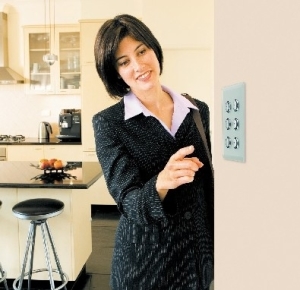Residential Lighting
From flipping lights on to dimming them down, controls can change the tune of your room and help you to save on energy bills.
By Craig DiLouie, LC
What you need to know:
- All lighting must be controlled
- Basic functions include switching (on/off) and dimming (raise/lower)
- Switching can be automated for energy savings and security
- Dimming can be tied together for convenient, single-button scene recall
- Room control systems can be tied together for whole-house control

Lighting controls offer homeowners flexibility and energy savings. Photo by Schneider Electric.
Lighting controls can transform a room from bright and airy to dusky and romantic with just the push of a button or the flick of a switch. By giving you a choice of different light levels, lighting controls allow you to create various moods and visual scenes to accommodate your preferences or to change the ambiance of a room. They also offer energy-saving benefits by turning off the lights when they’re not being used or by dimming the lights while they’re on.
What controls are right for your home? This depends on what you want to accomplish—saving energy or setting a scene using lighting (or both). Our handy lighting controls guide below details the types of controls—from basic switches to comprehensive whole-house controls—that can help you achieve your lighting objective.
Flip the Switch: Lighting Control Fundamentals
At the most basic level, all lighting requires controls that provide switching (on/off), dimming (raise/lower) or both. Here are options for controlling a single zone, lamp (light bulb) or group of lamps tied together on a single lighting subcircuit:
Switch: This simple control device turns the lights hardwired to it on and off.
Vacancy sensor: Suited for bathrooms and utility spaces, this automatic switch detects whether a room is occupied, and turns the lights off when it’s not, saving energy by making sure the lights are off when the room is not being used.
Timer switch: Ideal for utility spaces such as closets, these automatic switches, once set in the on position, turn the lights off after a predetermined time.
Dimmer switch: This device provides switching as well as dimming, which is the ability to raise or lower light output.
Beyond the Basics: Lighting Controls for Scene Setting
Room- and whole-house controls enable homeowners to control their lighting to an even more detailed degree than basic lighting controls. These types of controls allow you to set a scene, or a programmed visual effect achieved by dimming each layer of lighting to a different level. Scenes can change the ambiance of a room or accommodate different tasks, or activities, such as reading or watching television.
Preset scene control: The next step up from a single-load control device is room control, in which every light in the room is controlled individually or with other lights to create various lighting scenes. Suppose we layer the lighting in a room—ambient (or general), task and accent lighting—and want to separately control each layer, or even different groupings within each layer. We could assign a single dimmer to each of these zones, but in a large room with complex lighting needs, this can result in a lot of dimmers on the wall.
Preset scene control systems, or integrated dimmers with keypads, consolidate the functions of multiple dimmers into a single user interface. Scenes can be programmed for single-button recall. The keypad interface may be pushbutton, touchscreen, a wireless handheld remote or some other activator, and may be customizable.
Whole-house control: The next step up from room control is whole-house control. Just as preset scene controls tie together lighting layers into a single push-button room control system, a whole-house system ties these rooms into a single whole-house system. A whole-house lighting control system can include scene controllers (room or zone), a central controller (with timer and programming), dimming rack and processor (depending on the manufacturer), remote controls, vacancy/motion sensors, and related devices such as photosensors and various interfaces that can integrate lighting with other home systems such as home automation. From a few locations, you can control all of the lighting in the home, including programming, scheduling and push-button scene recall.
Wireless versus wired: For a home lighting control system to be responsive to its owner, the owner must be able to command the controls. The command is issued as a control signal, which in turn requires a communication pathway between connected devices in the system. Communication methods include line-voltage power wiring (powerline carrier), dedicated low-voltage wiring and infrared or radio-frequency (RF) wireless.
When choosing the control method that is right for you, remember that there is a distinct difference between controlling the lights and lighting control. To maximize flexibility, savings, security and lifestyle/convenience, consider going beyond the basic switch.